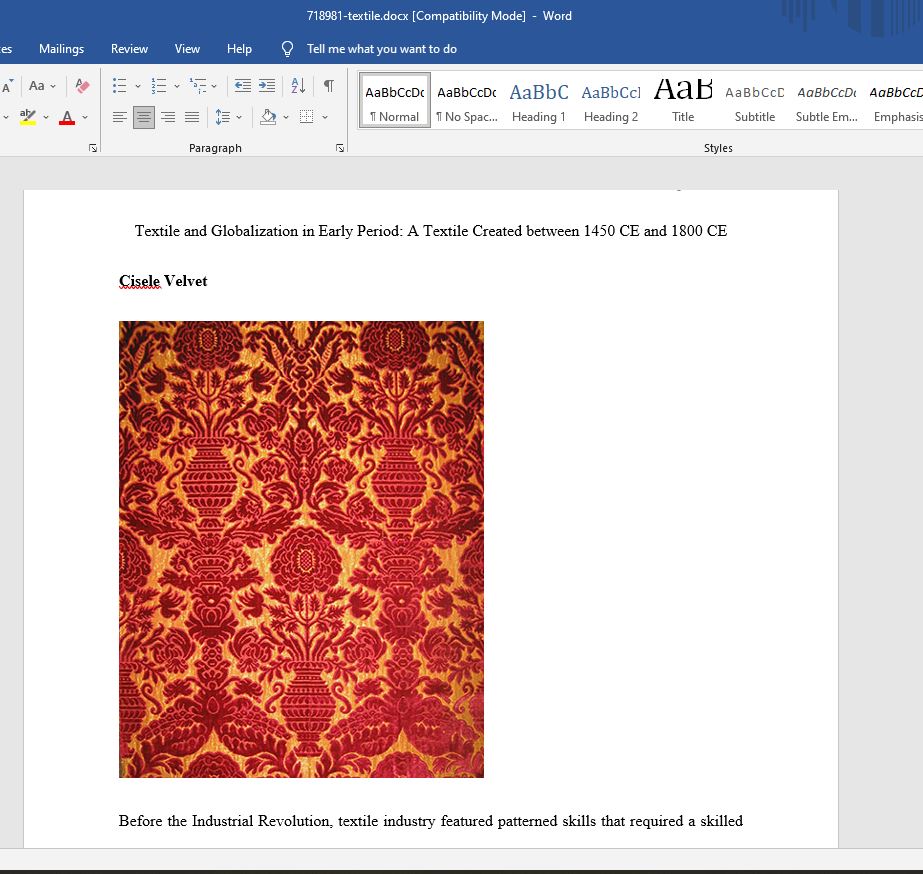Textile and Globalization in Early Period: A Textile Created between 1450 CE and 1800 CE
Assignment :Art History
Dear Students, A formal analysis (FA) is a required component of your final paper. Upload your draft FA via this assignment. I will comment on drafts and your revision should be inserted into your final paper. See this form for components of a formal analysis: Textiles_Formal Analysis-2017.docx
A formal analysis is YOUR description of the artwork/object.
From the final paper guidelines form: Disc Final Paper & Presentation guidelines 2017.pdf
A revised formal analysis (FA)) of chosen object/artwork must be in your final paper. The FA should be in first 1-2 pages of your paper.
Textiles and Globalism in Early Modern Period: Paper and Presentation guidelines
Please read all quidelines:
1. All papers should have the following components in their subject:
a) A textile created between 1450 CE and 1800 CE
b) A country we are studying or covered in readings, Europe, Ottoman Empire,
Early West African Textiles, India, Japan, Peru, North American. It is possible
to address a textile from another culture/country but you need approval of the
textile with evidence of available research to guide your conceptual approach
and research, for example cultural interchange and hybridity with Chinese
textile forms covered in several books on bibliography.
c) Papers may include images of other objects as comparisons as you establish
that your textile is not unique but rather one in a group of other similar objects
(of course you will explain in your paper how similar)
2. Each presentation and paper provide a thesis sentence and paragraph stating the claim
or argument you are making. This thesis directs the concepts developed in your paper
in relation to your chosen object/textile and represents your conceptual pursuits.
3. Conceptual approach to your chosen textile and paper should address topics
addressed in our lectures, readings and discussions. Terms like: Globalism,
Imperialism, Hybriditiy, Cultural reciprocity, Cultural contact, Colonialism and other
terms that address movement of peoples, processes and fiber textile information,
patterns and more during the Early Modern People.
4. Each presentation and paper must present scholarly research to support the thesis, as
evidence include a brief discussion of one scholars’ ideas/concepts that you found in
a journal or book that contribute to the support of your thesis (1-2 paragraphs). For
example, in the topic sentence identify the author, essay/book title and what this
scholar said – this can be a short quote or a close paraphrase and should be footnoted.
Then in 2-5 sentences synthesize the material i.e. discuss what this quote means to
you and how this information contributes or has resonance with your topic. Often this
may seem evident to you but it is important that you “spell it out” for your reader –
don’t make your reader do the work and guess what you think it means. Write it.
5. A revised formal analysis (FA)) of chosen object/artwork must be in your final paper.
The FA should be in first 1-2 pages of your paper.
6. If you use other images in your paper – tell your reader why you are using them and
how you are “reading” them. ID the image, date, and museum collection.
7. Include at least one paragraph describing the fiber and the process of production.
8. Please email if you have questions, I am available for meetings, assist with outlines,
review, edit drafts, thesis revisions and more.
9. Paper grading: Thesis (10 points), Formal Analysis (10 points) Research to support
thesis (35 points), Paragraph on scholar’s idea (10 points), Paragraph on fiber and
process of production (5 points) Style/grammar (10 points), Conclusion (5 points),
Footnotes (10 points) Bibliography (5 points).
10. References listed in your bibliography should include pertinent class readings, other
books, journals, and websites utilized. If you use a website, provide both the name
and the link to the site. Please use scholarly sites, .org or .edu are best
11. Double-spaced, 12 font, and 7-8 pages in content, title page and bibliography
Class presentations –
• Your presentation should include:
a) Briefly tell your reader audience about the artwork.
b) State your thesis or the main questions (2-3) that you are asking about this
object. These questions direct your research and become/evolve to your thesis.
c) Briefly describe the key information from your research that supports your
thesis idea.
d) You will have 8-10 minutes, which includes set-up and your presentation. So
plan on speaking for no more than 5 minutes!!!
Websites that are helpful in writing art history papers:
Perdue Owl https://owl.english.purdue.edu/owl/
This Hamilton.edu website offers info on writing a formal analysis and research for an art
history paper.
http://www.hamilton.edu/writing/writing-resources/writing-an-art-history-pap
Answer preview:
Word: 300

